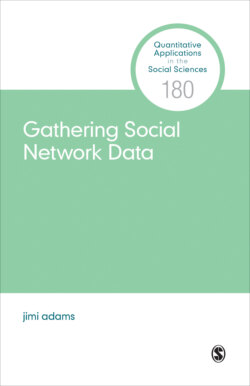Читать книгу Gathering Social Network Data - jimi adams - Страница 11
На сайте Литреса книга снята с продажи.
Chapter 1. Why Focus on Relationships?
ОглавлениеWhat is a social network? The way I answer that question has changed a lot since I started out in this field. Early in grad school, I was generally met with blank stares whenever I mentioned that my research focused on social networks. In the early 2000s, most people actually didn’t have much of a reference point for what that term might mean. Since my research at the time focused largely on sexually transmitted infections (STIs), I’d usually say something about how I examined the patterns of risk behavior interactions among a group of people. This meant we were aiming to systematically capture who was potentially (or actually) exposing others to an STI. That requires finding data on who was having (what types of) sex with whom or sharing injection needles with which others, and ideally, we were able to determine when each of these behaviors was taking place.
In the years since, my own research, the field as a whole, and, perhaps more important, the public’s reference point on social networks has broadened considerably. I’ve started studying things like information flows through populations and adolescents’ friendships—a bread-and-butter topic for social network analysts. Scholars now study things ranging from kinship ties to telephone calls, face-to-face interactions of individuals to resource exchanges between states, social support provision to voting behavior influence, and innumerable other possibilities. And the ubiquity of social media sites like Facebook and Twitter often mean that instead of being confronted with blank stares when describing “social networks” as our research focus, social network scholars now are faced with explaining how that variety of topics we study differs from (or at times aligns with) what those sites entail.
Essentially, social networks are the collection of relationships or interactions between members of a population of social actors.1 And this book is about how we gather data on those networks. I’ll use the generic term ties to represent any of these relationships (or interactions) between a pair of actors. This term stems from the common use of visual representations in social network scholarship, wherein lines are used to represent how these ties link two actors together. Network scholars generally refer to these actors as nodes (or vertices), terms adopted from graph theory and the strategy of representing them within visualizations as points or dots. In many social network applications, the social actors we’re interested in are people, with relationship states (like friendships) or interaction events (like conversations) occurring between them. However, instead of individuals, other studies may focus on collective nodes like organizations (e.g., studying formal collaborations between them) or countries (e.g., trade patterns across them). Generically, just as a network tie can represent any number of tie types, a network node can represent an individual or collective actor.2
1 I’ll differentiate relational from interactional data below.
2 Purely for simplicity of writing, I will not continue to highlight different units of analysis to which networks can be applied. I’ll generally focus examples on one level at a time. And the text will regularly rely on discussing individuals as the default type of node within a network study. This is merely a convenient shorthand, and organizational or other types of nodes could have been chosen equally appropriately.
Network research turns the analytic lens from the patterns across the characteristics of actors within a population (i.e., their attributes or behaviors) to the patterns among the ties between those actors. What might that look like?
